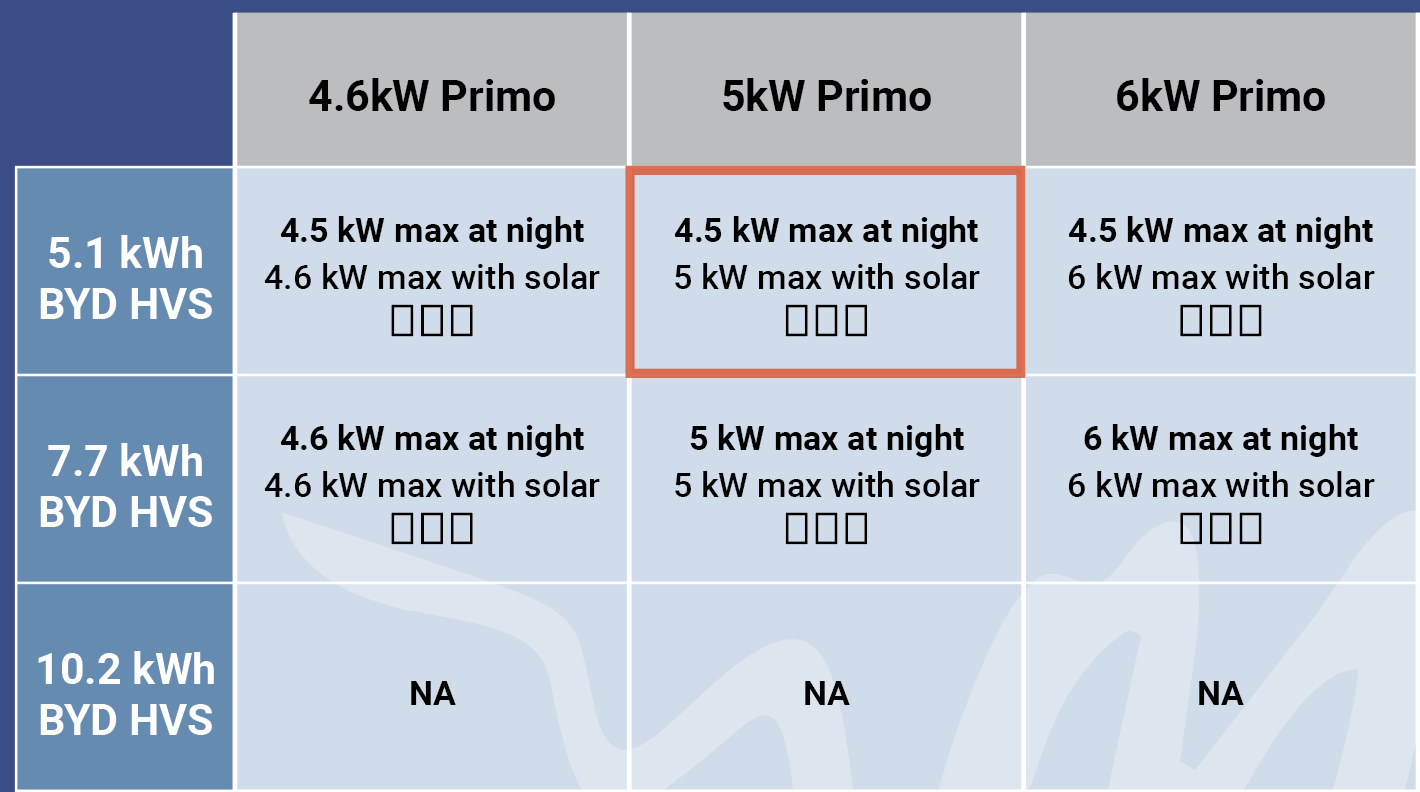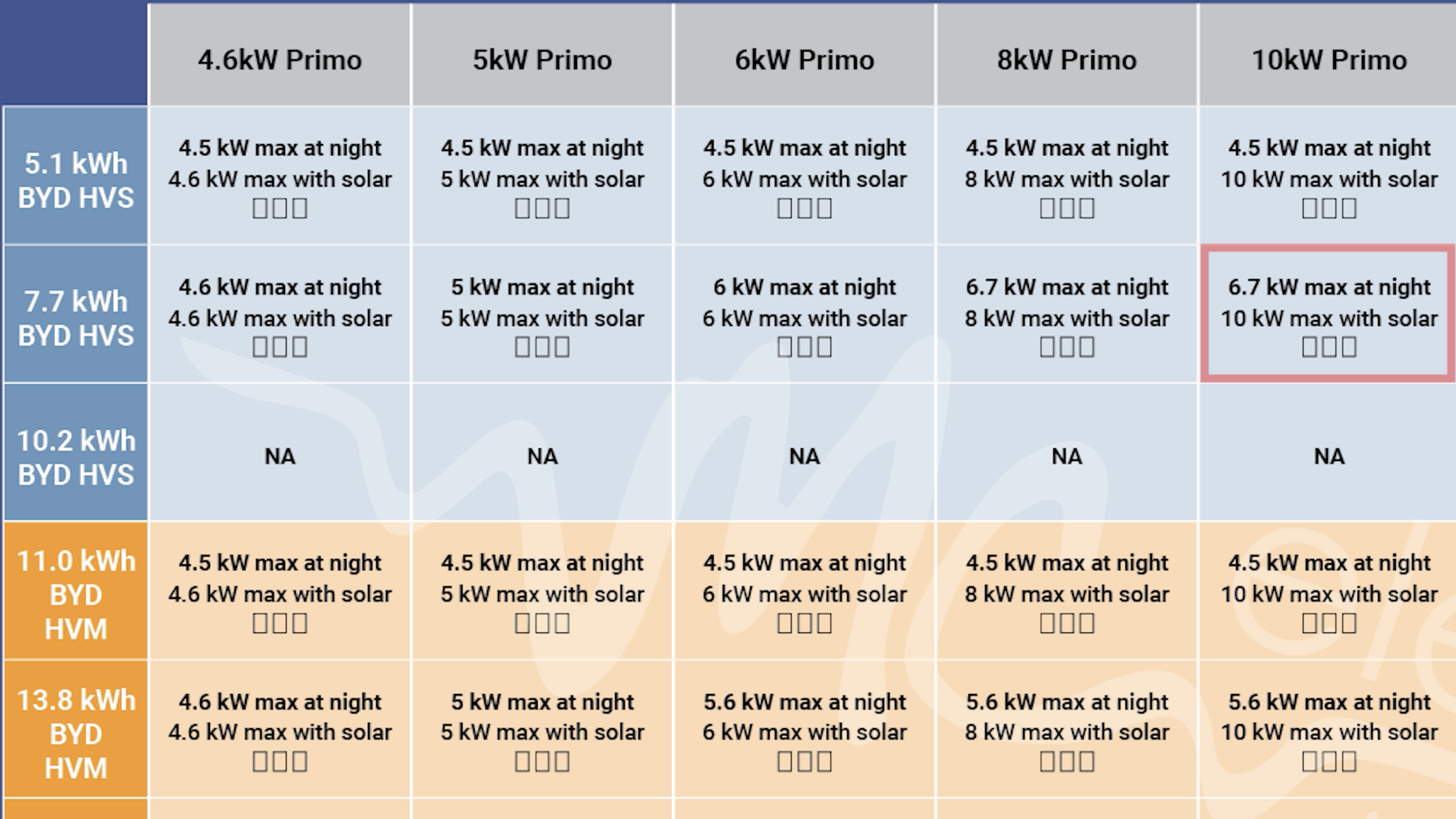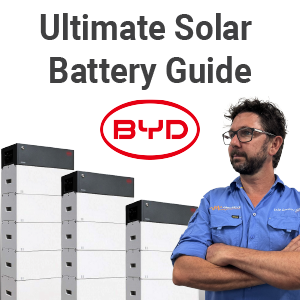If you are looking into adding a solar battery to your solar system, then you’ll want to understand not just the sizing options but how they vary in performance.
Solar batteries are not one size fits all, which is ONE reason why BYD’s modular and expandable solution can be an excellent option. This blog won’t just help with BYD, but it will help you understand the questions you should ask about any battery that you may want to add to your solar system.
BYD’s modular solution isn’t unique and the considerations you need to make are not unique to BYD. Even though you can simply add more BYD battery modules down the track, If you get the wrong combination of BYD batteries and inverter, it will be either expensive or impractical to upgrade.
I’ve put together this BYD / Fronius Gen24 battery sizing guide together, so you don’t end up installing a battery that lets you down when you need it most. Before I explain the sizing guide, if you don’t know the difference between a kW and kWh, check out this video for a really quick explanation.
If you would rather watch my explanation of my BYD Sizing Guide on YouTube, download the document below and watch the video “Ultimate Solar Battery Guide” video below.
The BYD Battery Sizing Guide

BYD Modular Solution
First, let’s talk about what modular means. Each of these modules is roughly 2.5 kWh of storage. So you basically stack a bunch of modules together to make up the size of battery you want. You need a base, for the bottom to lift the battery off the floor, and a battery conditioning unit, or a BCU on the top, to make sure the battery modules don’t run too hot or too cold.
If a few years later you want to increase the size of your battery, then you can add more modules to make the stack higher or add another stack of modules beside the first stack. Modular batteries are a great idea, but they also introduce a level of complexity when sizing the correct size battery for your needs.
BYD Sizing Guide Explained
The Sizing Guide is really just a summary of three limitations.
- The limitations of how many BYD modules you can stack together.
- The limitation of each BATTERY to charge and discharge.
- The limitations of each INVERTER to charge and discharge.
Looking at the sizing guide above, we can see two different types of BYD batteries, the HVS and the HVM. Think of HVS as Small and HVM as Medium.
HVS battery modules run on a higher voltage so we can only add between 2 and 4 modules per stack. This allows a range of 5.1kWh (2 modules) to 10.2kWh (4 modules) of storage. (Note that “Primo” inverters can only handle the voltage of 3 modules).
The HVM battery models use lower voltage modules, so we can stack anywhere from 4 to 8 modules per stack, giving a minimum of 11kWh and a maximum of 22.1kWh of storage per stack.

On the top row of the guide, there’s a list of Fronius Gen24 inverters that work with the BYD Battery. Look at the top row, and let’s choose the 5kW Primo inverter with a small 5kWh battery. This is the cheapest system. There is a link to pricing at the end of the blog. Can you see the issue with this battery? The only way you can go bigger than 7.7 is to install a completely new stack of batteries!

The 3 little squares indicate that you can add up to three stacks. But that involves the extra cost of another BCU and much more work installing it. If you were thinking of expanding, you may want to install an 11kWh battery to start with. Then you can easily expand to 19kWh of storage.
BYD HVM Charge / Discharge Limitations
Now let’s move on to the 10kW Fronius Primo inverter and say we install a 7.7kWh battery. Let’s explain the figures in the box.

The first figure is how fast the battery can charge and discharge. So, your battery will be limited at night or in a blackout by discharging at 6.7kW. If you need to use more power than this, you’ll need to get that power from the grid or your solar panels. Remember, this is also how fast the battery can charge. So at lunchtime, if your solar is cranking and you have 8kW of excess solar, not all of that will go to the battery; it will be limited to charge at a rate of 6.7kW.
Now let’s say you are in a blackout – but the sun is out, so the solar is working. You can draw a maximum of 6.7kW from your battery, but you can draw more power from your panels. You’ll now just be limited to the output of the inverter, in this case, 10kW.
The squares below mean you can add three separate stacks, but that is a more expensive way of doing it. So maybe you should have chosen the 11kWh HVM battery to start with.

So here is the weird part of the sizing of the BYD battery. Let’s step up and get an 11kWh HVM battery. Well, this battery will charge and discharge SLOWER than the 7.7kWh HVS battery – at a rate of 4.5kW. You might have storage capacity, but the rate at which you can use that capacity is limited. If you want the battery to charge and discharge faster, you’ll need to up the size of your HVM battery stack.
Fronius Gen24 Symo Inverter Limitations
Now let’s look at the Fronius Symo inverters. These inverters can only be used if you have 3-phase power at home. (That’s what “Symo” stands for).
We’ll look at the 10kW Symo and put a 22kWh battery on it. (This size is bang-for-buck. See our pricing.)
- The first figure shows us how fast the battery can charge and discharge – 9kW
- The second figure shows how much you can get from your solar and battery combined – 10kW
- And the third figure refers to how much you can get from each phase. Notice every Symo inverter is the same – 3.68kW.

So, let’s say you have a 3-phase Fronius inverter, you decide to back up your whole house, and you are running a large 3.6kW hot water system, and then you turn on your aircon which is on the same phase. Your battery could discharge at this rate, and while you are connected to the grid, you’ll have no problems.

But if you are running the system in a blackout, and your hot water system is on a “backup circuit” you’ll overload that phase of the inverter, and your solar will trip off in overload.

Your Fronius inverter will reset, and your power will come back on, but you’ll need to turn off one of your appliances so it doesn’t overload again. With a 3-phase inverter, we usually advise against backing up appliances like a large hot water system.
If, on the other hand, you had a single-phase Fronius inverter, everything would be on one phase, and you could run up to 10kW on the one phase.
However, as I explain in this video, there are disadvantages to using a larger single-phase inverter, particularly export limiting.
Choosing a solar battery of any kind is not as simple as choosing the size of the battery. You also need to consider how practical it is to upgrade that battery should your consumption habits change. You also want to consider how fast that solar battery will charge and discharge, paying close attention to those figures if you have a 3-phase system.
And if you’re wondering if a Tesla Powerwall might work better than the BYD, check out this video where I compare the two.
If you are in South East Qld and would like a hand sizing a battery system, contact us for a quote or call 07 3268 3836. We’d love to help out!


















